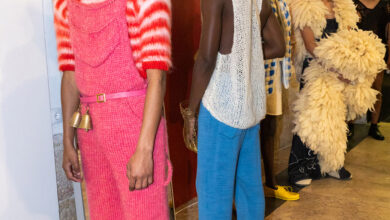TIM WALKER AND THE DREAM OF THE LOST EXPLORER
 Tim Walker’s fashion shoots always have something extravagantly exuberant and theatrically surreal about them: pastel-coloured Persian cats pose under clematis bushes; girls are suspended bait-like on giant fishhooks; horses are photographed inside a house, while white rabbits happily hop around a room. In each picture there is a certain English eccentricity and at times there is also an irresistible overdose of kitschness that has the power of transporting you to a faraway magic land.
Tim Walker’s fashion shoots always have something extravagantly exuberant and theatrically surreal about them: pastel-coloured Persian cats pose under clematis bushes; girls are suspended bait-like on giant fishhooks; horses are photographed inside a house, while white rabbits happily hop around a room. In each picture there is a certain English eccentricity and at times there is also an irresistible overdose of kitschness that has the power of transporting you to a faraway magic land.
By Anna Battista
Patrick McGrath’s stories are instead imbued with the tension and fear of Gothic novels while being also sprinkled with a certain sense of sublime à la Edmund Burke.
But what would happen if Walker’s visions would be used to give life to one of McGrath’s stories? The answer is very simple and it’s entitled “The Lost Explorer”.
This short story by McGrath first published in the 1989 collection Blood and Water and Other Tales was turned by Walker into a 20-minute film last year. The film was launched in September during London Fashion Week at a Mulberry event and, since then, it was screened at different festivals and events.
Publisher teNeues recently released a book featuring McGrath’s story, Walker’s photographs and the annotated script for the film. Walker’s fans will be happy to know that there is also a very limited edition available from the same publisher that includes a DVD of the film.
“The Lost Explorer” is a dark tale with a 12-year-old girl named Evelyn as main protagonist. Young Evelyn finds a lost Victorian explorer in a tent at the bottom of her parents’ garden. The man is feverish with malaria and clutching a revolver, fearing the pygmies are out to kill him.
Evelyn takes care of him, but a tragic fate awaits the explorer and his shocking death will represent for the young girl a rite of passage from childhood into adulthood.
In gothic novels Hell was tangibly manifest in prisons, castles and deformed monsters, but in McGrath’s story it is evoked by the Kurtz-like nightmares of the explorer.
The medical theme that also appeared in Asylum and Spider (born in London in 1950, McGrath grew up near Broadmoor Hospital where for many years his father was medical superintendent), appears also in this story: Evelyn’s father is indeed a surgeon and the young girl becomes genuinely worried about the explorer’s health, hoping she will be able to find a cure for his malaria.
Throughout the years quite a few of McGrath’s works were turned into films, from The Grotesque, adapted into a film and released as Gentlemen Don’t Eat Poets (1995; directed by J.P. Davidson) to Spider (2002; directed by David Cronenberg) and Asylum (2005; directed by David Mackenzie).
But while in these adaptations directors emphasised the darkest aspects of the stories, Walker tried to inject in “The Lost Explorer” a healthy dose of magic (sur)realism.
While the tent of the lost explorer in the film seems almost lifted from Walker’s 2002 image of tents in a library from the “It rained outside, so we camped inside” shoot at Chanters House in Devon, the film also includes a scene featuring Evelyn (Olivia Campbell), the explorer (Richard Bremmer) and 300 canaries flying around a ghost-like ship trapped inside the ballroom of a Georgian mansion.
This scene is actually not part of McGrath’s story, but inspired by the tales Walker heard about the clippers sailing from Africa with cages full of birds that would be released halfway to allow them to stretch their wings (since they couldn’t find any land, the birds would have to fly back to the ship).
Often compared to Cecil Beaton, Norman Parkinson, Irving Penn and Will McBride, Walker has a fundamental secret: in his shoots he usually photographs his subjects as if they were the protagonist of a fairy tale, transfiguring them with his dreamy and hallucinated visions.
Absurd and fabulous, ingenuous and sensual, Walker’s work is mesmerising also thanks to his famous over-the-top props: for a Christmas photo shoot he once used an enormous amount of objects, including ballerina tutus, Christmas trees, ostrich eggs, gigantic plastic hands and a horse.
Fans will remember Lisa Cant dressed like a Playboy bunny girl surrounded by eighty white rabbits; Coco Rocha being engulfed in a cloud that echoed Magritte’s cloud paintings and images from Bertha and Florence K. Upton’s 1895 book The Adventures of Two Dutch Dolls and a Golliwogg being turned into a fashion photoshoot.
Walker filmed “The Lost Explorer” in a relatively short time, roughly eight days, with a crew that comprised also his collaborator Shona Heath who created the costumes for this film.
The fashion-photographer-turned-filmmaker has now set his eyes on another ambitious project hoping one day to turn into a film Iain Banks’s seminal first novel The Wasp Factory.
It may be a challenge, but somehow you can already picture in your mind the opening scenes with the camera lingering on the rat and seagull heads on the sacrifice poles. A Iain Banks story directed by Tim Walker? Looking forward to seeing it.
“The Lost Explorer” by Patrick McGrath and Tim Walker is published by teNeues and is out now.
64 pp., Hardcover with jacket
47 color photographs
Text in English
Book Size: 21 x 24.5 cm / 8 1/4 x 9 2/3 in.
39,90 EUR
clamshell box, DVD and a signed and numbered photoprint
47 color photographs
Text in English
Book Size: 21 x 24.5 cm / 8 1/4 x 9 2/3 in.
Box Size: c. 27.5 x 30.5 cm / 10 10/16 x 12 in.
Non-returnable
1.250,00 EUR








